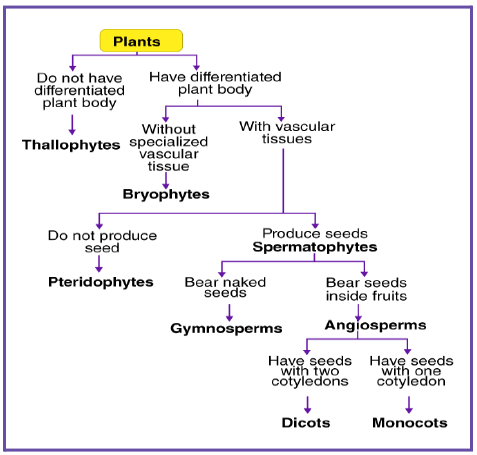JAMB Exam > JAMB Notes > Biology for JAMB > Plantae: Plant Kingdom
Plantae: Plant Kingdom | Biology for JAMB PDF Download
| Table of contents |

|
| Classification |

|
| Characteristics |

|
| Algae |

|
| Bryophytes |

|
| Pteridophytes |

|
| Gymnosperms |

|
| Angiosperms |

|
Classification
- The plant kingdom is divided into five major divisions: Thallophyta, Bryophyta, Pteridophyta, Gymnosperms, and Angiosperms.
- Thallophyta includes algae and fungi-like organisms.
- Bryophyta consists of non-vascular plants such as mosses and liverworts.
- Pteridophyta comprises vascular plants that reproduce via spores, including ferns and horsetails.
- Gymnosperms are seed-bearing plants with naked seeds, such as conifers.
- Angiosperms are flowering plants with enclosed seeds and are the most diverse group of plants.
Characteristics
- Plants are multicellular eukaryotes with cell walls made of cellulose.
- They possess chloroplasts containing chlorophyll for photosynthesis.
- Most plants exhibit alternation of generations, having a haploid gametophyte and a diploid sporophyte stage.
- Plants have specialized tissues for transport (xylem and phloem) and support (stems, roots, and leaves).
- They reproduce sexually through the production of gametes, and some can also reproduce asexually.
Algae
- Algae are photosynthetic organisms found in diverse habitats like freshwater, marine environments, and moist soil.
- They range from single-celled to multicellular forms.
- Examples include green algae, brown algae, red algae, and diatoms.
Bryophytes
- Bryophytes are non-vascular plants that lack true roots, stems, and leaves.
- They require a moist environment for reproduction because they depend on water for fertilization.
- Mosses and liverworts are common examples of bryophytes.
Pteridophytes
- Pteridophytes are vascular plants that reproduce via spores.
- They have true roots, stems, and leaves.
- Ferns, horsetails, and clubmosses are examples of pteridophytes.
Gymnosperms
- Gymnosperms are seed-producing plants in which seeds are not enclosed in fruits.
- They have well-developed vascular tissues.
- Conifers, cycads, and ginkgoes are examples of gymnosperms.
Angiosperms
- Angiosperms are flowering plants with seeds enclosed in fruits.
- They have highly evolved reproductive structures, including flowers and fruits.
- Angiosperms are further classified into monocots and dicots based on the number of cotyledons in their seeds
 Fig. Classification of Plant Kingdom
Fig. Classification of Plant Kingdom
The document Plantae: Plant Kingdom | Biology for JAMB is a part of the JAMB Course Biology for JAMB.
All you need of JAMB at this link: JAMB
|
224 videos|175 docs|151 tests
|

|
Explore Courses for JAMB exam
|

|
Signup for Free!
Signup to see your scores go up within 7 days! Learn & Practice with 1000+ FREE Notes, Videos & Tests.
Related Searches
















